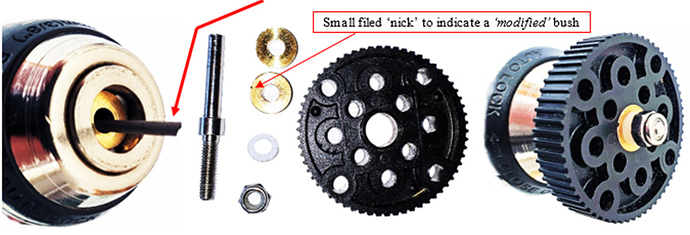It has been frequently reported here that Ranger wheels often stick and prevent the model from moving or the robot not driving correctly - a fault often dismissed as being caused by low battery power. This happen to me, with just one of the free-turning wheels and it was NOT battery power related. After several tests I thought that the problem might be something to do with the recessing of the central hub of the wheels to allow the bushes to seat inside them correctly.
I worked out that the holes through the two bushes on either side of the wheel might not quite be in the same alignment - but how was I to ream them out, as if they were one aligned unit?
My solution to this was to mount a wheel (with two bushes) on to the threaded part of a short spindle and loosely secure it with a Nylock locking nut. I then put the smooth part of the spindle into the chuck of an electric drill and turned it on (for about a minute) whilst I firmly held the on to the wheel!
This meant that the threaded part of the shaft was revolving inside the two bushes (which, remember, were assembled in true alignment with each other) - so, would the thread act as a simple abrasive device to free-up the wheel and allow it to spin freely?- YES it did! - and with a bit of wiggling of the wheel (to improve the abrading effect of the threaded shaft spinning inside the bushes) it did seem to work very well. Success, and everything now worked OK!
Check for the motor shaft rubbing where it passes through the chassis holes too & slacken & re-adjust the motor’s securing two screws to fix this if necessary.


